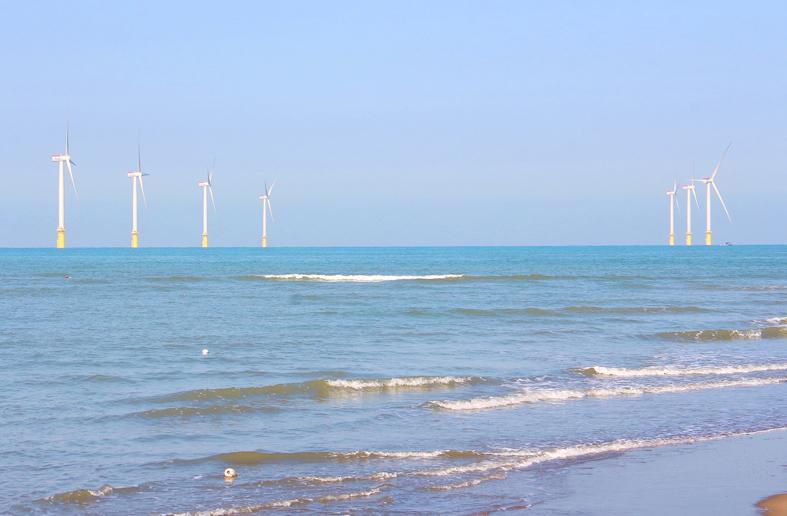Taiwan’s local content requirements for offshore wind farms do not contravene WTO rules, Minister of Economic Affairs Wang Mei-hua (王美花) said yesterday.
“During the second phase of offshore wind farm development, projects were awarded by selection or by auction,” Wang said. “The projects awarded by selection have to abide by rules concerning Taiwan-made components.”
“It is true that we have encountered problems with implementing local content requirements, but we have since made adjustments,” Wang said. “We are highly cognizant and respectful of WTO rules.”

Photo: CNA
Wang made the remarks in response to calls from EU officials on Tuesday for Taiwan to drop the requirements.
Cristina Lobillo Borrero, director for Energy Policy Strategy and Coordination at the European Commission, urged Taiwan to comply with WTO rules.
“Excessively strict demands regarding local content requirements would lead to higher costs, which would eventually be absorbed by consumers,” Borrero said.
Taiwan’s local content policy is designed to encourage the buildup of a local “green supply chain” for the offshore wind farm industry.
However, international developers, mostly from Europe, have complained that the requirements are overly onerous.
A position paper from the European Chamber of Commerce Taiwan earlier this year described the requirements as “inflexible” and “broad,” and said they would lead to “a noncompetitive and ultimately underutilized local supply chain.”
“Taiwan’s current item-based local content policy risks creating a separate, less competitive Taiwan market for these items rather than building its suppliers into successful global competitors,” the paper said.
As of Jan. 1, the crew of ships working on Taiwan’s offshore wind farms must be at least one-third Taiwanese, putting a heavy burden on marine construction companies, said Holly Chu (朱佑翎), a senior associate with the law firm Eiger.
“If the ship passes through Taiwanese waters, you have to have one-third Taiwanese crew,” Chu said. “If you tried and failed to find qualified candidates, you have to set up a training program.”
“The Europeans do not feel like Taiwan is following WTO rules. Taiwanese feel like they are. I cannot tell you who is right, but the problem is that we are not creating a competitive industry,” she said.
Local suppliers, knowing international developers have no choice but to buy from them, have no incentive to improve price or quality, Chu said.
The localization scheme benefits local firms without creating future export potential, she said.
“They can lie on their backs and still make money,” she added.
The scheme should be percentage-based rather than item-based, she said, adding that a proposal to change the rules has been sent to the Industrial Development Bureau.
If 30 percent of a project, regardless of which parts or services, has to come from local firms, it would give “developers the choice which items to buy from local suppliers, but the idea was previously snubbed,” Chu said.
The rules for phase 3 offshore wind farm development, including localization requirements, are yet to be determined.
In its most ambitious phase till date, the government aims to add 1 gigawatt of offshore wind energy every year for 10 years.
The announcement of the new rules, initially set for Monday, was postponed until after the Tomb Sweeping Day long weekend.
An offshore wind farm developer who declined to be named said that the Bureau of Energy might use the time to make some last-minute adjustments and announce the rules next week.

To many, Tatu City on the outskirts of Nairobi looks like a success. The first city entirely built by a private company to be operational in east Africa, with about 25,000 people living and working there, it accounts for about two-thirds of all foreign investment in Kenya. Its low-tax status has attracted more than 100 businesses including Heineken, coffee brand Dormans, and the biggest call-center and cold-chain transport firms in the region. However, to some local politicians, Tatu City has looked more like a target for extortion. A parade of governors have demanded land worth millions of dollars in exchange

An Indonesian animated movie is smashing regional box office records and could be set for wider success as it prepares to open beyond the Southeast Asian archipelago’s silver screens. Jumbo — a film based on the adventures of main character, Don, a large orphaned Indonesian boy facing bullying at school — last month became the highest-grossing Southeast Asian animated film, raking in more than US$8 million. Released at the end of March to coincide with the Eid holidays after the Islamic fasting month of Ramadan, the movie has hit 8 million ticket sales, the third-highest in Indonesian cinema history, Film

Taiwan Semiconductor Manufacturing Co’s (TSMC, 台積電) revenue jumped 48 percent last month, underscoring how electronics firms scrambled to acquire essential components before global tariffs took effect. The main chipmaker for Apple Inc and Nvidia Corp reported monthly sales of NT$349.6 billion (US$11.6 billion). That compares with the average analysts’ estimate for a 38 percent rise in second-quarter revenue. US President Donald Trump’s trade war is prompting economists to retool GDP forecasts worldwide, casting doubt over the outlook for everything from iPhone demand to computing and datacenter construction. However, TSMC — a barometer for global tech spending given its central role in the

Alchip Technologies Ltd (世芯), an application-specific integrated circuit (ASIC) designer specializing in server chips, expects revenue to decline this year due to sagging demand for 5-nanometer artificial intelligence (AI) chips from a North America-based major customer, a company executive said yesterday. That would be the first contraction in revenue for Alchip as it has been enjoying strong revenue growth over the past few years, benefiting from cloud-service providers’ moves to reduce dependence on Nvidia Corp’s expensive AI chips by building their own AI accelerator by outsourcing chip design. The 5-nanometer chip was supposed to be a new growth engine as the lifecycle